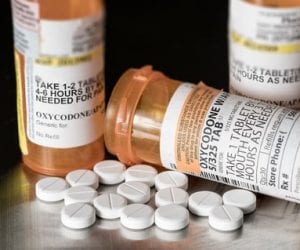Percocet
 Percocet is a synthetic opioid used to treat moderate to severe pain. It is the brand name for the combination of Oxycodone and acetaminophen. Oxycodone is a pain relieving narcotic and Acetaminophen is a moderate pain relieving analgesic. When combined, acetaminophen enhances Oxycodone’s painkilling effects therefore reducing the need for a stronger narcotic. Together these drugs work synergistically to bind opioid receptors in the brain and spinal cord to effectively reduce pain.
Percocet is a synthetic opioid used to treat moderate to severe pain. It is the brand name for the combination of Oxycodone and acetaminophen. Oxycodone is a pain relieving narcotic and Acetaminophen is a moderate pain relieving analgesic. When combined, acetaminophen enhances Oxycodone’s painkilling effects therefore reducing the need for a stronger narcotic. Together these drugs work synergistically to bind opioid receptors in the brain and spinal cord to effectively reduce pain.
Percocet is a frequently prescribed pain medication in the United States and certainly one of the most abused. As a result, the drug has acquired a number of slang names used on the street to describe the drug such as:
- Percs
- Paulas
- Roxi’s
- Roxicotten
- Blues
- Blue dynamite
Percocet comes in tablet form in a range of shapes and colors that are based on the dosage strength. The primary shape for these tablets are round, oval or oblong and colors can be white, peach, pink and yellow. However, products sold illegally as Percocet may differ from these descriptions.
Drug Classifications
Percocet is rated as a narcotic analgesic combination drug. It is classified as a Schedule II Controlled substance by the Food and Drug Administration (FDA). Drugs in this category has a currently accepted medical use with severe restriction in the United States community and a high potential for abuse. This drug is legally administered by prescription only.
Signs of Percocet Abuse
Abuse and addiction to prescribed medications like Percocet usually stay under the radar of family members and friends and even to the abuser themselves longer than illicit drug use. That is because taking a narcotic medication that was legally prescribed to treat a painful condition is not an anomaly. As a result, the signs and symptoms of abuse or addiction tend to continue unhindered until the drug abuse becomes a full blown addiction or a deadly overdose situation occurs. The most common signs of Percocet abuse includes:
Behavioral
- A preoccupation with getting prescription refills and maintaining supply of Percocet.
- Visiting multiple doctors or purchasing Percocet online or from drug dealers.
- Stealing, borrowing or lying to get money to buy drugs.
- A growing disinterest in work or school performance and responsibilities
- Needing to take the drug to get through the day
- A lack of interest in one’s appearance or personal hygiene.
Physical and Psychological
- Shifts in personality and mood swings
- Depression and suicidal thoughts
- Unusually irritable, displays of rage and anger
- Restless and unable to sleep
- Paranoia
- Distorted perception of reality
- Nausea and vomiting
- Disorientation or confusion
Long Term use and abuse of Percocet may lead to respiratory and cardiovascular complications, kidney disease, gastrointestinal problems, liver dysfunction and mental disorders.
According to the Substance Abuse and Mental Health Services Administration (SAMHSA), the number of emergency room visits due to prescription pain medication overdose increased from 100,000 to over 300,000 in a twelve month period.
Percocet History and Trends
Percocet was first referred to as “Meperidine” when it was formulated in Germany in 1939. Although its initial use was not that of a painkiller, the potency and efficiency of the drug in this regard soon became evident which led to it use as a painkiller. The drug was placed in ampules and administered by injection. For years, this medication was believed to be less harmful than morphine and as a result was widely prescribed to people under this false assumption. However, as addictions began to manifest in patients using the drug, it led to further research which later confirmed the drugs addictive properties.
The FDA approved the use of Percocet in the United States in 1976. However, in June of 2009, due to, the number of people who were developing addiction, liver damage and multiple overdose deaths, the administration placed additional restrictions on drugs containing narcotic analgesics and acetaminophen. Even with these restrictions Percocet continues to be widely available and the cause of rampant addiction, sickness and death.
Treatment for Percocet Addiction
Addiction to Percocet presents numerous withdrawal symptoms when use is halted. Withdrawal symptoms can include fever, chills, body aches and pain, hypertension, exacerbated heart rate, tremors, panic attacks, seizures and depression among others. As such, it is highly recommended that withdrawal from habitual use of Percocet occur with around the clock medical oversight. A medical detox help to alleviate undue suffering and minimize any health complications that, without proper and immediate treatment, could be fatal.
Recovery in our state of the art medically equipped drug rehab treatment centers provide the support and expertise of board certified addiction clinicians to facilitate complete recovery form Percocet addiction. Our rehabilitation programs are customized and incorporate evidence based traditional, holistic and innovative cutting edge remedies that enable clients to achieve full recovery. Relapse prevention education and training also provide tools that help people in recovery to enjoy long term sobriety.
Call our drug rehab treatment centers to day at 877-855-3470 if you or a loved one is suffering from addiction to Percocet. We can help.